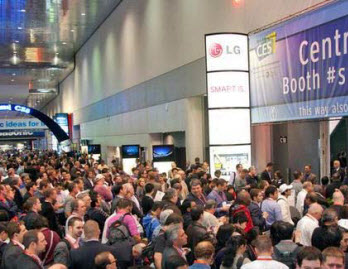CES 2017: Invisible Threads, Very Sparkly!

LAS VEGAS — On the day before CES opened, a seven-mile trek through the ever-expanding exhibit space — way beyond the Las Vegas Convention Center, into surrounding hotels — indicated that our appetite for gadgetry is apparently endless.
This year marked the 50th birthday of CES, described on the morning news here as “the Woodstock of electronics,” and there’s little that wasn’t captured and shared instantly, as it happened — thanks, by the way, to the broadband connectivity this industry built.
First, then, a brief look back: Not unlike that World’s Fair in Chicago in 1893, lots of things that we now take for granted were debuted at a CES. The World’s Fair gave us Cracker Jacks, the Ferris wheel, and moving walkways; CES begat the VCR (1970s), Atari (1975), the Commodore 64 computer (1982), HDTV (1998) and hundreds of other developments that did and did not make it beyond the show floor.
Ten years ago at CES, for instance, we were (sadly) talking weird acronyms like OCAP (OpenCable Applications Platform) and “CHILA” (Cable Host Interface Licensing Agreement); that was was the year of the awkward press conference, hosted by CableLabs, declaring the deployment of OCAP headends and hardware. Sprint was touting its JV with cable operators; Sony touted its “Passage alternate conditional access system, that lets MSOs use other vendors than Scientific-Atlanta and Motorola to secure premium content.”
Gateway Computer hosted private meetings to discuss its looming “sneak attack” of selling flat panel displays. Phones with built-in cameras (what!) were on the drawing board, as was a his-and-hers nightlight, located in the toilet bowl, and an Internet-connected defibrillator, which dialed 911 when activated.
Five years ago, “Ultrabooks” were the thing, and “superphones” included a 13-megapixel camera. LG introduced a “blast cooler,” which chilled a can of beer from lukewarm to frosty in five minutes.
The point is that CES is about things. Stuff. Objects, made of plastic, with buttons and lights and screens and sound.
This year, it was still about things, stationary and airborne (talk about Drone City), but it was as much or more about the invisible threads trying to weave those things together. Threads like artificial intelligence, fueled by machine data, to inform the analytic algorithms that make products, care and services better.
Also: security. Last year will remembered for lots of horrible things, but as it relates to our stuff, it was a banner year for hacks — ransomware, to bring down hospital operating rooms, really? Really. Lots of attacks on the things of the Internet of Things, left on default settings. Candy for a hacker.
From a connectivity perspective, there was wireless and mobility. Getting there is a choice of three options: Build, buy or rent. Building is expensive and too late. Buying is expensive and risky. Which pretty much explains MVNO agreements, so in vogue.
One thing we saw on the CES floor — a continuation from the last few years — were products and services aimed at making our WiFi lives better. Intel, for instance, was touting its work with Comcast and RDK (Reference Design Kit) on what is probably the most dope router ever.
The intent is for it to be, for broadband, what X1 was (and is) for video. It’s based on RDK-B, where the B stands for Broadband; Intel’s part is its Puma 7 chip, which has RDKB on board as its primary stack for all of its routers and gateways. (That alone is a big deal.)
And, of course, the weird stuff. My favorite: A levitating, waterproof Bluetooth speaker. Other weird stuff: A connected cocktail machine, a wristband that alleviates nausea, an auto-lacing shoe, a pollution-fighting “smart scarf” and a fitness-tracking ring. (We saw one two years ago, but it was doughnut-sized.)
That’s this report from Vegas, where we again traipsed through a million-plus square feet of digital confetti. Viva!
Stumped by gibberish? Visit Leslie Ellis at translation-please.com or at multichannel.com/blog/translation-please.
Multichannel Newsletter
The smarter way to stay on top of the multichannel video marketplace. Sign up below.



